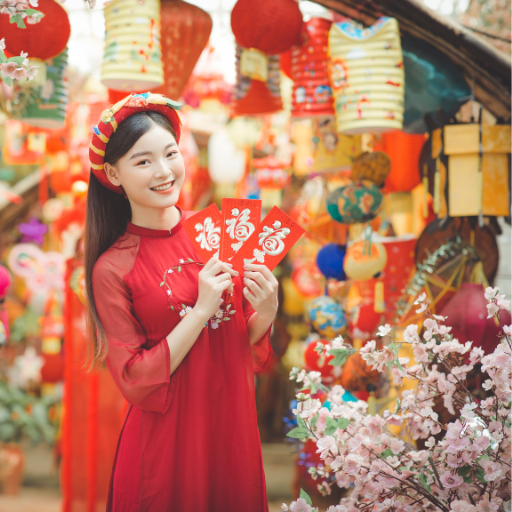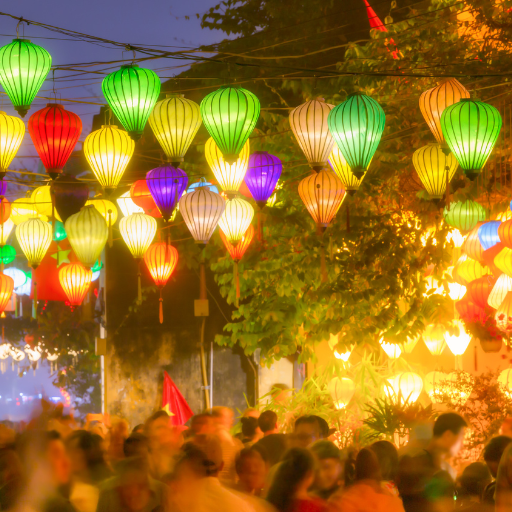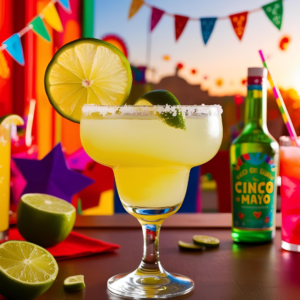
The Lunar New Year, known as Tết Nguyên Đán or simply Tết, is the most significant and anticipated celebration in Vietnam. This vibrant festival marks the arrival of spring and the start of a new lunar calendar year. Tết is steeped in centuries of tradition, blending elements of Vietnamese culture, history, and spirituality. Its origins, however, are as intriguing as the festival itself, rooted in the agricultural heritage and ancient beliefs of the Vietnamese people.
In this article we will talk first of its origins in Vietnam (to understand the meaning of this celebration), and later we will talk about how is celebrated now the Tet Parade in Westminster California.
Agricultural Beginnings
The origin of Tết is closely tied to Vietnam’s agrarian past. As a predominantly agricultural society, ancient Vietnamese communities were deeply connected to the cycles of nature, particularly the rhythms of the lunar calendar. The New Year celebration was initially a time to honor the cycle of the seasons and to express gratitude to the gods and ancestors for a bountiful harvest.
The timing of Tết aligns with the lunar calendar, typically falling between late January and mid-February. This period corresponds with the end of the winter season and the arrival of spring, a time of renewal, growth, and optimism. Farmers used this transitional period to rest, prepare for the next planting season, and honor the natural world that sustained their livelihoods.
Mythological Roots
The celebration of Tết is also deeply intertwined with Vietnamese folklore and mythology. One of the most well-known legends involves the Kitchen Gods (Táo Quân). According to the story, the Kitchen Gods are a trio of deities who oversee the household and report the family’s deeds to the Jade Emperor in heaven at the end of each lunar year. In preparation for this celestial report, Vietnamese families clean their homes, offer sacrifices, and ceremoniously release carp fish, which are believed to carry the Kitchen Gods to heaven.
Another legend central to Tết revolves around Lang Liêu, the prince who created bánh chưng (square sticky rice cake) and bánh tét (cylindrical sticky rice cake). Lang Liêu’s humble yet meaningful cakes, symbolizing the Earth and Sky, were presented to the king during a competition to find a successor. These cakes became an essential part of Tết, representing gratitude and the harmony of nature.
Chinese Influence
Vietnam’s proximity to China and its long history of cultural exchange also shaped the development of Tết. During the period of Chinese rule (from 111 BCE to 938 CE), many Chinese customs and traditions were introduced to Vietnam, including the celebration of the Lunar New Year. However, the Vietnamese adapted these traditions to suit their unique cultural identity.
For instance, while both countries celebrate the Lunar New Year, the Vietnamese version emphasizes family reunions, ancestor worship, and the preparation of specific traditional dishes like bánh chưng and bánh tét. Additionally, Tết reflects the Vietnamese people’s reverence for their own folklore, deities, and agricultural customs, which distinguish it from its Chinese counterpart.
Evolution Over Time
As Vietnamese society evolved, so too did the traditions of Tết. During the feudal era, emperors and mandarins would hold elaborate ceremonies to honor the gods and ancestors. The New Year was also a time for the monarch to issue decrees, host festivals, and strengthen ties between the government and the people.
Under French colonial rule in the 19th and 20th centuries, Tết traditions were further influenced by modernity and global exposure. However, the essence of the festival—family, renewal, and gratitude—remained intact. Tết even played a critical role during Vietnam’s independence movements, serving as a symbol of cultural pride and resilience.
Modern-Day Tết
Today, Tết is a harmonious blend of ancient and contemporary practices. In the weeks leading up to the holiday, families clean their homes, settle debts, and shop for festive decorations. Bright red and gold adorn streets and homes, symbolizing prosperity and good fortune. Markets overflow with kumquat trees, peach blossoms, and marigolds, all believed to bring blessings in the new year.
The celebration itself lasts several days, beginning on the eve of Tết with a family feast. Offerings are made to ancestors, and firecrackers (where allowed) are lit to ward off evil spirits. During the holiday, people visit relatives, exchange well-wishes, and give lì xì (red envelopes containing money) to children and the elderly. Each activity reflects a shared hope for happiness, health, and success in the coming year.
Tết: A Festival of Unity
At its core, Tết is a celebration of unity. It brings families together, fosters connections with ancestors, and strengthens communal bonds. It serves as a reminder of Vietnam’s rich cultural heritage and the resilience of its people. While the world continues to change, Tết remains a timeless anchor, deeply rooted in the Vietnamese spirit and a vibrant celebration of life.
By understanding the origins of Tết, one gains a deeper appreciation for its significance and the enduring cultural identity of Vietnam. More than just a New Year’s celebration, Tết is a living tradition that honors the past, celebrates the present, and looks forward to the future.

Celebrate the Tet Parade in Westminster California.
As the first new moon of the lunar calendar rises, Westminster, California, becomes a kaleidoscope of colors, sounds, and traditions celebrating the Vietnamese Lunar New Year, Tết Nguyên Đán—or simply Tết. This joyous time is more than just a change of the calendar; it’s a celebration of cultural heritage, family unity, and prosperity that deeply resonates with the Vietnamese community. Westminster, home to Little Saigon and one of the largest Vietnamese communities outside Vietnam, has turned Tết into an event that captivates locals and visitors alike.
Westminster’s Role: A Vibrant Hub for Tết Celebrations
While Vietnam buzzes with Tết festivities, Westminster has emerged as a cultural beacon for Vietnamese-Americans who carry on these cherished traditions. Westminster is home to Little Saigon, a cultural and economic hub where Vietnamese heritage thrives. Here, the celebration of Tết has taken on a life of its own, becoming one of the most anticipated events for both the local community and visitors.
With its rich cultural tapestry, Westminster brings Tết to life in a way that’s both authentic and uniquely Californian. The city transforms into a festive wonderland with streets lined with vendors selling traditional delicacies, performances that showcase centuries-old art forms, and a contagious sense of excitement that pulls you into the celebration.
What Makes Tết in Westminster Unforgettable?
The Tết Parade: Picture this: floats adorned with golden dragons, marching bands playing spirited tunes, and groups performing the iconic lion dance. The Tết Parade in Westminster is nothing short of spectacular. This event draws thousands of spectators each year, showcasing the best of Vietnamese culture, from traditional áo dài-clad participants to modern interpretations of heritage. It’s an Instagram-worthy spectacle that blends cultural pride with community spirit.
The Asian Garden Mall: Known as Phước Lộc Thọ to locals, the Asian Garden Mall is the heart of Little Saigon and a focal point for Tết celebrations. During the festive period, the mall buzzes with life. Stalls brimming with bánh chưng (sticky rice cakes), lì xì (red envelopes), and other Tết essentials line the space. Live performances, from folk music to modern pop, keep the crowds entertained, while the tantalizing aroma of Vietnamese street food lingers in the air.
Cultural Performances and Traditions: From intricate calligraphy demonstrations to traditional storytelling, Westminster’s Tết celebrations provide an immersive cultural experience. Lion and dragon dances, performed to the rhythm of drums and cymbals, are a must-see. These dances, believed to bring good luck and drive away evil spirits, are a central part of Tết festivities.
Community Spirit: Beyond the parades and performances, Tết in Westminster is about community. Families come together to share meals, exchange lì xì, and reflect on their blessings. For visitors, it’s a chance to experience the warmth and hospitality of the Vietnamese community—a perfect reminder that Tết is as much about human connection as it is about tradition.
A Culinary Celebration
If you’re a foodie, Westminster during Tết is paradise. Vietnamese cuisine, already celebrated for its fresh and vibrant flavors, takes on a special significance during the new year. Signature dishes like bánh chưng (square sticky rice cakes filled with pork and mung beans) and bánh tét (a cylindrical variation) are must-tries. Other delights include giò lụa (Vietnamese pork sausage), canh khổ qua (bitter melon soup), and a colorful array of candied fruits.
And let’s not forget the drinks. Whether it’s a warm cup of jasmine tea or a sweet sip of chè, there’s no shortage of culinary offerings to tantalize your taste buds.
Why Visit Westminster for Tết?
Westminster’s Tết celebrations stand out because they offer a blend of tradition and modernity. The city’s Vietnamese-American community has seamlessly integrated age-old customs with contemporary American influences, creating a festival that feels timeless yet fresh.
Moreover, the scale and energy of the celebrations are unparalleled. Little Saigon is recognized as one of the largest Vietnamese communities outside of Vietnam, and it shows. The sheer enthusiasm with which Westminster celebrates Tết rivals that of any city in Vietnam. This is where heritage comes alive, and everyone—regardless of background—is invited to participate.
Fun and Festivity with a Dash of Humor
Let’s face it: we could all use a little extra luck in the new year, and Tết provides plenty of opportunities to stock up. Whether it’s catching a lucky candy tossed from a parade float, snagging a perfect Instagram shot with a lion dance performer, or earning a coveted red envelope (hey, it’s for the kids, but no judgment here), Tết in Westminster is as fun as it is meaningful.
Plus, where else can you find a celebration where you leave with a full belly, a better appreciation for Vietnamese culture, and possibly the best-smelling kumquat tree in Southern California?
Chúc Mừng Năm Mới! (Happy New Year!)
As the saying goes, “New year, new me!” But in Westminster, it’s more like, “New year, same amazing community!” Tết is the perfect time to explore all that Westminster has to offer, from its vibrant cultural scene to its thriving local businesses. Whether you’re Vietnamese or simply Vietnamese-curious, the city’s Lunar New Year celebrations are not to be missed.
So mark your calendar, grab your friends and family, and head to Westminster this Tết season. Experience the joy, taste the flavors, and immerse yourself in the traditions that make this celebration one of the most exciting events of the year.
This year the Tet Parade will be on Saturday, February 1st in Bolsa Avenue (between Magnolia Street and Bushard Street). For more information check the next page: https://www.westminster-ca.gov/departments/community-services/tet-parade




